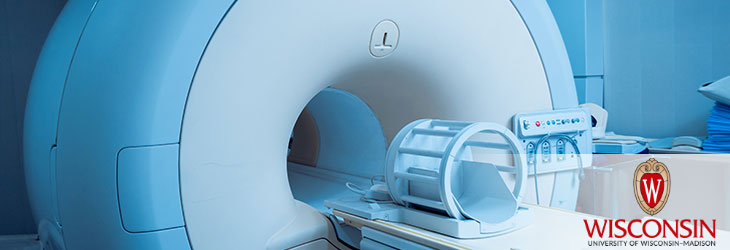Radiation Therapy

Scanning Aperture Ion Beam Range Compensator and Intensity Modulator for External Radiation Therapy
WARF: P07279US
Inventors: Thomas (Rock) Mackie, David Westerly, Ryan Flynn
The Wisconsin Alumni Research Foundation (WARF) is seeking commercial partners interested in developing a technique for external beam ion radiation therapy that modulates an area beam by using a shutter system to increase treatment speed while maintaining high precision.
Overview
External beam radiation therapy is a tumor treatment technique that directs one or more high-energy radiation beams to the tumor. Advanced external beam radiation systems treat tumors with multiple X-ray fan beams that can be rotated around the patient. Each beam consists of individual “beamlets” whose intensity can be controlled to allow for the treatment of complex tumor shapes. However, x-ray energy still is deposited to all tissue along the entire path of the beam up to the exit point.
An alternate beam radiation therapy technique involves the use of ions such as protons to treat tumors. This technique dramatically reduces the radiation dose to healthy tissue when compared with X-ray radiation therapy using photons. The dose intensity from protons is not uniform along the beam path and rises to a “Bragg peak” near a point where the proton beam stops completely. Controlling the placement of the Bragg peak so it is located on the tumor reduces the amount of radiation delivered to the patient’s healthy tissue. Unlike X-ray radiation therapy, ions allow for separate control of the total dose of radiation (intensity) and distance the Bragg peak occurs (range).
Existing proton therapy techniques utilize one of two methods. The spread out Bragg peak (SOBP) approach spreads the ion beam out into an “area beam” using scattering foils and brass collimators to cover the entire tumor in one exposure. This method is fast, but is less precise and requires a special compensator to adjust for the tumor shape. The magnetic spot scanning (MSS) approach uses the original ion “pencil beam” and steers it around the tumor with successive exposures. Due to the multiple exposures the process is slow. The potential for high accuracy is negated due to patient movement, which risks missing tumor areas.
An alternate beam radiation therapy technique involves the use of ions such as protons to treat tumors. This technique dramatically reduces the radiation dose to healthy tissue when compared with X-ray radiation therapy using photons. The dose intensity from protons is not uniform along the beam path and rises to a “Bragg peak” near a point where the proton beam stops completely. Controlling the placement of the Bragg peak so it is located on the tumor reduces the amount of radiation delivered to the patient’s healthy tissue. Unlike X-ray radiation therapy, ions allow for separate control of the total dose of radiation (intensity) and distance the Bragg peak occurs (range).
Existing proton therapy techniques utilize one of two methods. The spread out Bragg peak (SOBP) approach spreads the ion beam out into an “area beam” using scattering foils and brass collimators to cover the entire tumor in one exposure. This method is fast, but is less precise and requires a special compensator to adjust for the tumor shape. The magnetic spot scanning (MSS) approach uses the original ion “pencil beam” and steers it around the tumor with successive exposures. Due to the multiple exposures the process is slow. The potential for high accuracy is negated due to patient movement, which risks missing tumor areas.
The Invention
UW–Madison researchers have developed a technique for external beam ion radiation therapy that modulates an area beam by the use of a shutter system to increase treatment speed while maintaining high precision. The shutters can control beam intensity independently to eliminate the need for a special compensator.
This technique uses an area beam that is occluded with a set of longitudinally opposed and latitudinally adjacent shutter pairs. Each shutter of each pair is controllable and can extend to different longitudinal distances. The shutters can control the range of the beam to conform to complex tumor shapes and can be steered around like a pencil beam while maintaining the proper range for the tumor.
This technique uses an area beam that is occluded with a set of longitudinally opposed and latitudinally adjacent shutter pairs. Each shutter of each pair is controllable and can extend to different longitudinal distances. The shutters can control the range of the beam to conform to complex tumor shapes and can be steered around like a pencil beam while maintaining the proper range for the tumor.
Applications
- Ion beam radiation therapy for the treatment of tumors
Key Benefits
- Allows for independent control of intensity and range
- Increases accuracy of beam placement
- Increases treatment speed
Additional Information
Related Technologies
Related Intellectual Property
Tech Fields
For current licensing status, please contact Jeanine Burmania at [javascript protected email address] or 608-960-9846